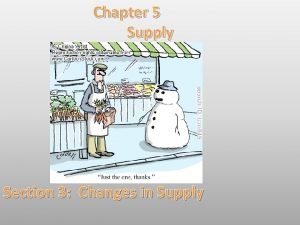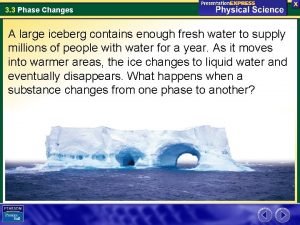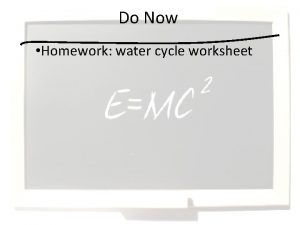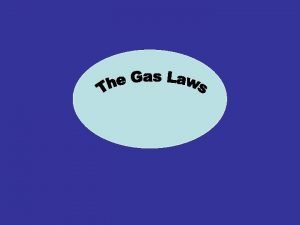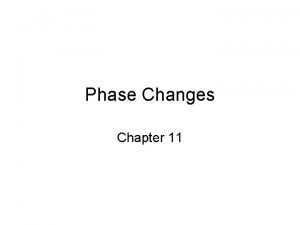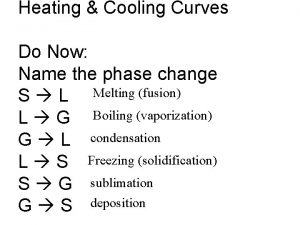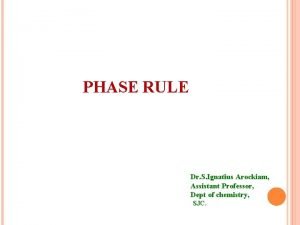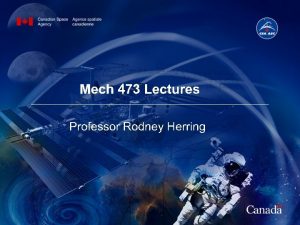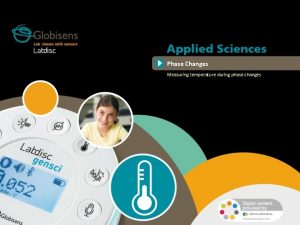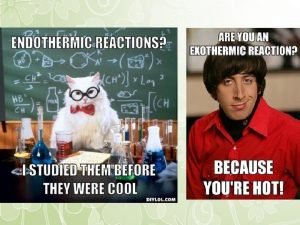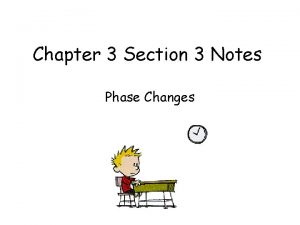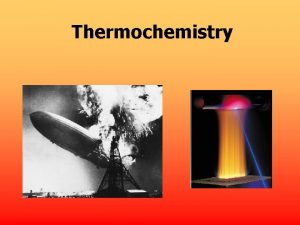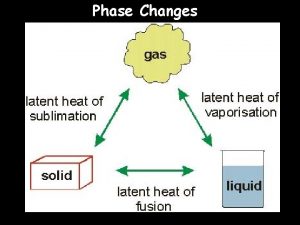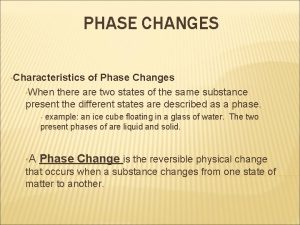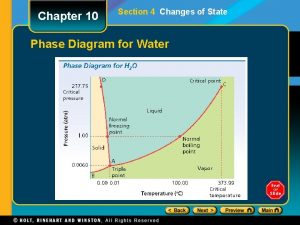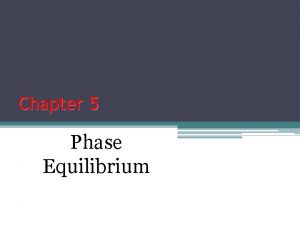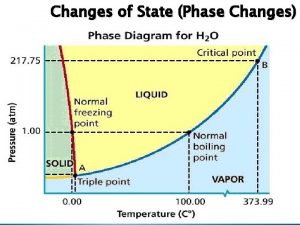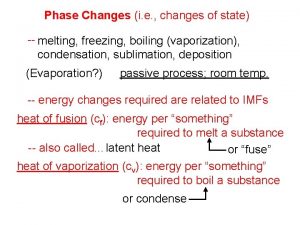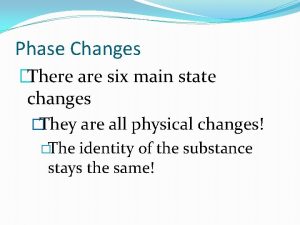Changes of State Phase Changes Chapter 3 Section

























- Slides: 25

Changes of State Phase Changes Chapter 3, Section 2

Review from last Time • 1. What are the 5 states of matter? – Solid – Liquid – Gas – Plasma – BEC (Bose Einstein Condensate) • 2. How do the molecules move in the 3 main states? – 3 Main States of Matter

1. States of Matter

States & phases • Each of the 5 states is also known as a phase. • Elements and compounds can move from one • • • phase to another phase when special physical forces are present. One example of those forces is temperature. The phase or state of matter can change when the temperature changes. Generally, as the temperature rises, matter moves to a more active state.

What about temperature? ? ? Tell us about it Tim & Moby! • Click here


It’s all about the energy! • It’s totally possible to go from a solid to a liquid • • • to a gas, and back again. These are called state changes or phase changes. But it’s all about the energy. Which state you go to depends on whether you are adding or removing energy.

States & Energy • During a change of state, the energy of the • • • substance changes. This is related to how the particles move. If you add energy to a substance, the particles speed up. If you remove energy from a substance, the particles slow down. In fact, temperature is a measure of the speed of particles. Brain. Pop: Heat


See, proof! • Each state has a different energy “requirement”. • In order to be a plasma, you need a ton of • energy because your particles better be moving! In order to be a solid or BEC, the particles are fine just chilling - so they don’t need as much energy.

Two Types of Energy Change 1. Endothermic: energy is absorbed, or taken in, by a substance (absorbs heat - feels colder) 2. Exothermic: energy is removed, or taken out, of a substance (releases heat - feels warmer)

Endothermic and Exothermic Requires Energy Endothermic Releases Energy Exothermic

2. An Endothermic Experiment • Endothermic: • energy is absorbed, or taken in, by a substance (absorbs heat feels colder) Think of the ice bags the coach gives you if you get hurt

3. An Exothermic Experiment Exothermic: energy is removed, or taken out, of a substance (releases heat feels warmer)

IS THAT A FACT? ? Did you know, water is the only substance on Earth that can be found as a solid, liquid, and a gas at normal surface temperatures.

4. The Phases of Water


Brainpop: Tim & Moby • The Water Cycle

Melting: Solid to liquid • Let’s start with an ice cube. • This ice cube starts off as a solid. • When we add heat (energy), it begins to melt into a liquid.

How does melting work? • When a substance is heated, it absorbs energy and its atoms and molecules begin oscillating, or moving. • Eventually, they move so much that they break some of their bonds of attraction which are holding them tightly in place. • They move so vigorously that they begin to move past one another, flowing like a liquid. • Thus, as energy is being absorbed, this is an endothermic change.


• The melting point of a substance is the temperature at which a substance changes from the solid to liquid. • Melting points range from low temps to very high temps. • The melting point is typically a very unique property of a substance. • We can use melting points to determine the identity of a substance.

Awful Science Humor • A small piece of ice which lived in a test • • tube fell in love with a Bunsen burner. "Bunsen! my flame! I melt whenever I see you" said the ice. The Bunsen burner replied: "It's just a phase you're going through. ”

Vaporization: Liquid to Gas • Now let’s take that water and put it • • • into a pot over flame. Eventually, the water will start to boil and turn into a gas. Vaporization is the name of this process. Boiling is vaporization that occurs throughout a liquid. The temperature at which a liquid boils is its boiling point. The boiling point of water = 100ºC

How does boiling work? • When you’re heating a pot of • water, the heat energy is making the water molecules move faster and faster. When enough thermal energy (heat) is added, the intermolecular forces in the substance are completely overcome and the liquid becomes a gas.
 Chapter 5 section 3 changes in supply
Chapter 5 section 3 changes in supply Chapter 5 section 3 changes in supply
Chapter 5 section 3 changes in supply Chapter 6 section 2 changes in market equilibrium
Chapter 6 section 2 changes in market equilibrium Normal phase vs reverse phase chromatography
Normal phase vs reverse phase chromatography M tswett pronunciation
M tswett pronunciation Mobile phase and stationary phase
Mobile phase and stationary phase Stationary phase and mobile phase in hplc
Stationary phase and mobile phase in hplc Normal phase vs reverse phase chromatography
Normal phase vs reverse phase chromatography Phase to phase voltage
Phase to phase voltage Adsorption chromatography
Adsorption chromatography In a triangle connected source feeding a y connected load
In a triangle connected source feeding a y connected load Broad phase vs narrow phase
Broad phase vs narrow phase Example of deposition
Example of deposition Is vaporization endothermic or exothermic
Is vaporization endothermic or exothermic 6 phase changes
6 phase changes Phase changes worksheet answers
Phase changes worksheet answers Phase changes
Phase changes Stp law
Stp law Are phase changes reversible
Are phase changes reversible Is vaporization endothermic or exothermic
Is vaporization endothermic or exothermic Phase changes
Phase changes Elizabeth mulroney
Elizabeth mulroney Physicl change
Physicl change Chapter 1 principles of government
Chapter 1 principles of government Mathematical expression of gibbs phase rule is
Mathematical expression of gibbs phase rule is Lever rule fe-c phase diagram
Lever rule fe-c phase diagram

